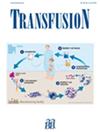Recruiting blood donors to the Canadian Blood Services Stem Cell Registry: A feasibility assessment.
IF 2.5
3区 医学
Q2 HEMATOLOGY
引用次数: 0
Abstract
BACKGROUND Allogeneic hematopoietic cell transplantation remains limited when stem cell registrants cannot be contacted, are not medically fit, are unavailable, or unwilling to proceed. In a recent report, registrants who were prior blood donors were more likely to be available for donation. In this study, we analyzed extent to which recruiting blood donors to the Canadian Blood Services Stem Cell Registry (CBS SCR) can meet targets for ethnic diversity, age, and proximity to collection facilities. METHODS AND RESULTS We analyzed 124,496 active blood donors on July 1, 2023 regarding the criteria for recruitment to the CBS SCR. A total of 40,518 (32%) were younger than 36 years of age and 49% were first-time donors (potential new recruits year over year). The ethnicity of blood donors younger than 36 years aligns more closely with the 2021 Canadian census compared to stem cell donors who were also previous blood donors, and to the current total inventory of all registrants on the CBS SCR. Of the blood donors, certain ethnic groups, including Black, Chinese, and First Nations/Indigenous, remain underrepresented. A greater proportion of active whole blood donors live within 400 km of a stem cell collection center (91%) compared to stem cell donors who donated during the past 10 years (80%). CONCLUSIONS Recruitment of blood donors offers an opportunity to improve the ethnic diversity of the CBS SCR and increase proximity of registrants to stem cell collection centers. The potential improved availability of registrants when matched to patients requires confirmation.加拿大血液服务干细胞登记处招募献血者:可行性评估。
背景当无法联系到干细胞注册者、医学上不适合、无法提供或不愿意进行移植时,异体造血细胞移植仍然受到限制。在最近的一份报告中,曾献血的注册者更有可能进行捐献。在这项研究中,我们分析了加拿大血液服务机构干细胞登记处(CBS SCR)在招募献血者时能在多大程度上达到种族多样性、年龄和距离采集设施近的目标。方法和结果 我们对 2023 年 7 月 1 日的 124,496 名活跃献血者进行了分析,以了解加拿大血液服务机构干细胞登记处的招募标准。共有 40,518 名献血者(32%)的年龄小于 36 岁,49% 的献血者是首次献血者(逐年增加的潜在新献血者)。36 岁以下献血者的种族与 2021 年加拿大人口普查结果更接近,而干细胞捐献者也曾是献血者。在献血者中,某些种族群体,包括黑人、华人和原住民/土著人的比例仍然偏低。与过去10年捐献的干细胞捐献者(80%)相比,居住在干细胞采集中心400公里范围内的全血活跃捐献者比例更高(91%)。注册者与患者匹配后,其可用性可能会提高,这一点需要确认。
本文章由计算机程序翻译,如有差异,请以英文原文为准。
求助全文
约1分钟内获得全文
求助全文
来源期刊

Transfusion
医学-血液学
CiteScore
4.70
自引率
20.70%
发文量
426
审稿时长
1 months
期刊介绍:
TRANSFUSION is the foremost publication in the world for new information regarding transfusion medicine. Written by and for members of AABB and other health-care workers, TRANSFUSION reports on the latest technical advances, discusses opposing viewpoints regarding controversial issues, and presents key conference proceedings. In addition to blood banking and transfusion medicine topics, TRANSFUSION presents submissions concerning patient blood management, tissue transplantation and hematopoietic, cellular, and gene therapies.
 求助内容:
求助内容: 应助结果提醒方式:
应助结果提醒方式:


